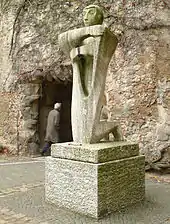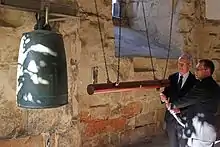Aegidienkirche, Hanover
The Aegidienkirche was a church in Hanover, the capital of Lower Saxony, Germany. It was one of three churches in the Old Town, the others being the Marktkirche and the Kreuzkirche. It was destroyed in World War II, and was left in ruins as a war memorial.
| Aegidienkirche | |
|---|---|
 | |

| |
| 52.3694°N 9.7392°E | |
| Location | Hanover |
| Country | Germany |
| Denomination | Lutheran |
| Website | www |
| History | |
| Status | War memorial |
| Architecture | |
| Style | Gothic |
| Completed | 1347 |
| Administration | |
| Parish | Marktkirche, Hanover |
| Deanery | Hanover City |
| Synod | Church of Hanover |
History
The church was built in the 14th century in the centre of Hanover,[1] succeeding a chapel,[1] and a Romanesque church built in 1163. The western wall of that church is partly extant.[1] The church was dedicated to Saint Giles, one of the Fourteen Holy Helpers. The present Gothic building was built in 1347[1] of sandstone from the Deister. The Reformation in Hanover began in this church.[1] The steeple was decorated with a Baroque facade in 1703 to 1711, designed by Sudfeld Vick. The interior of the church was remodeled in 1826 by Georg Ludwig Friedrich Laves who used columns from cast iron.[1]

The church was destroyed in a 1943 air-raid on the city,[1] as was most of the old town, including the other two churches. It was left in ruins as a war memorial. A monumental sculpture in the interior was designed in 1959 by Kurt Lehmann and called Demut (Humility).[1] Several Baroque epitaphs are featured on the outer walls. One of them, for Susanna Magdalena Oldekop, who died in 1648 as a child, shows her with an angel. The Siebenmännerstein shows a relief of seven praying men who, according to legend, sacrificed themselves at the Döhren Tower to rescue the town. The epitaph at the church is a copy of the original which is held by the Historisches Museum Hannover.[2] The Aegidienkirche has belonged to the Marktkirche parish from 1982.[3]

In 1985, the Japanese sister city of Hanover, Hiroshima, donated a peace bell (bonshō) which is installed close to the tower.[1] It is used in an annual service on Hiroshima Day, 6 August.[4]
Literature

- Conrad Wilhelm Hase. Baumeister des Historismus. Ausstellungskatalog. Historisches Museum am Hohen Ufer, Hannover 1968. Seite 41: Restaurierung der Aegidienkirche 1886–1887.
- Helmut Knocke, Hugo Thielen: Hannover. Kunst- und Kultur-Lexikon. Handbuch und Stadtführer. 3rd rev. ed. Hannover: Schäfer 1995, pp 61–63.
- Martin-G. Kunze: Marktkirche – Aegidienkirche – Kreuzkirche – Nikolaikapelle. Merkmale mittelalterlicher hannoverscher Stadtgeschichte. In: Kirchen, Klöster, Kapellen in der Region Hannover. Sascha Aust (et al.). Fotografien von Thomas Langreder. Hannover: Lutherisches Verlagshaus 2005, pp 13–22. ISBN 3-7859-0924-1
- H. H. Leonhardt: Die St. Aegidien-Kirche zu Hannover im Wandel von sechs Jahrhunderten, Hannover 1947
- Arnold Nöldeke: Die Kunstdenkmäler der Provinz Hannover. 1: Regierungsbezirk Hannover. Heft 2: Stadt Hannover. Teil 1: Denkmäler des "alten" Stadtgebietes Hannover. Hannover 1932, S. 115–130 (die Aegidienkirche vor der Zerstörung 1943).
- Helmut Plath: Die Ausgrabung in der Ägidienkirche zu Hannover. Ein Beitrag zur Bau- und Frühgeschichte der Stadt Hannover. In: Hannoversche Geschichtsblätter. issue 6 (1953), pp 3–86.
References
- "Mahnmal Aegidienkirche". Hanover (in German). Retrieved 6 November 2017.
- Wehking, Sabine. "Nr. 29: Stadt Hannover, Historisches Museum, Andachtsbild. 1480. [= Siebenmännerstein]". Inschriften der Stadt Hannover (in German). Retrieved 7 November 2017.
- "Geschichte der Altstadtkirchen Hannover". rundfunk.evangelisch.de (in German). Retrieved 27 October 2017.
- "Hiroshima". Hanover. Retrieved 7 November 2017.
External links
| Wikimedia Commons has media related to Aegidienkirche (Hannover). |